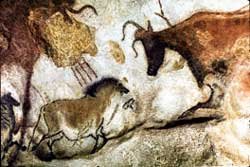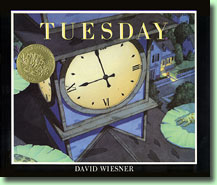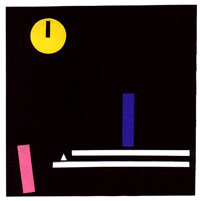 50,000 years ago, distant relatives of ours began telling each other stories
by painting pictures on the walls of caves. The one shown at left is in France,
and shows hunters and the animals they hunted.
50,000 years ago, distant relatives of ours began telling each other stories
by painting pictures on the walls of caves. The one shown at left is in France,
and shows hunters and the animals they hunted.
<- Intro
to Visual Communication home DOWNLOAD
Assignment 9: Single-frame
story | STORY: Jack & The Beanstalk | Rumplestiltskin | Little Red Riding Hood
 50,000 years ago, distant relatives of ours began telling each other stories
by painting pictures on the walls of caves. The one shown at left is in France,
and shows hunters and the animals they hunted.
50,000 years ago, distant relatives of ours began telling each other stories
by painting pictures on the walls of caves. The one shown at left is in France,
and shows hunters and the animals they hunted.
Perhaps the idea was to teach others, perhaps it was to brag about the success of the greatest hunters. Either way, this type of storytelling worked then, even before language was developed. Afterwards, even as spoken, then written, language developed, pictures remained as effective as ever.
Of course it's still true today. From cartoons to computer-based multimedia, we use visual elements to communicate with each other, often more clearly than we can with words.
While it helps to be able to draw, strangely enough that's not the most important skill of an effective visual storyteller.
More important is the ability to choose the most important elements to show. There are only so many visual details you can include in a single image. If you show too many details, the visual gets cluttered. If you show too few, there may not be enough information to understand the story. If you choose the wrong details, you may tell a different story from the one you intended.
 The cover from
David Wiesner's book, Tuesday, uses a few dramatic elements to focus
on the heart of the story: frogs that fly into town one Tuesday. Notice the
lily pads at the edges of the picture?
The cover from
David Wiesner's book, Tuesday, uses a few dramatic elements to focus
on the heart of the story: frogs that fly into town one Tuesday. Notice the
lily pads at the edges of the picture?
Although the story is about frogs—pretty much—you can hardly see them in the illustration. Instead, the clock dominates the picture. What are we to make of this? Well, like the clock striking midnight in the story of Cinderella, I suspect that 9 p.m. is a very important time in this story.
The viewpoint, high above the town, almost higher than the clock tower, clearly says "flying." At the same time, the yellow light streaming from the door of the house on the street below indicates some activity. Perhaps someone has just run out the front door.
These are the three key elements: clock, flying frogs, something happening in one house below. We see an intriguing mystery that we want to explore.
As an aside, you can get a sense of the process artist Wiesner uses to develop his ideas, by looking at the various stages of an illustration from the book: thumbnails, rough drawing, finished drawing, final painting. Unfortunately it's not the cover.
Start with a familiar fairy tale/story and break it into the most important parts:
Once you've listed all the places, characters, objects, and events, and you've identified the most important conflict or challenge, decide which of these are absolutely essential to tell the story. Most stories include lots of details and subplots to keep them interesting. To tell the same story visually without words you'll need to strip it down to a few elements. They have to be the right ones for this to work. It's probably best to start by picking the key event that defines the story.
Take the Cinderella story, for example. There are pumpkins and rats and slippers and stepsisters and a carriage and a ballroom, just to mention a few of the elements.
Which of these are most important? It depends on what you choose as the key event.
Here's what one student decided:

She chose as the critical event the moment that the clock strikes twelve. The setting is the steps outside the ballroom. The only characters needed are the prince and Cinderella. And the objects, the clock and the slipper. Put these together and you've captured the essence of the Cinderella story. From one perspective. Keep in mind that you could choose a different event in the same story and come up with a completely different visual solution. The possibilities are endless.
Students illustrated a variety of fairytales. See if you can tell which is which when you look at these samples.
Visual Storytelling, the book (website).
99 Ways to Tell a Story website/book
[TOP]
OTHER WEEKS:
WK1
| WK2 | WK3
| WK4 | WK5
| WK6 | WK7
| WK8 | WK9 | WK10
| WK11 | WK12
| WK13 | WK14
| WK15 | WK16
Visit Al's website, Interactive Design Forum | Send Al email